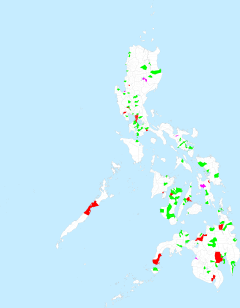Municipalities of the Philippines
 |
| This article is part of a series on the politics and government of the Philippines |
|
Legislature
|
|
Constitutional Commissions |
| This article is part of a series on |
| Administrative divisions of the Philippines |
|---|
|
Provinces and ind. cities |
|
Municipalities and comp. cities |
|
Barangays |
| Administrative division codes (ISO) (FIPS) |
| Cities and municipalities of the Philippines |
|---|
 Highly urbanized cities
Independent Component cities
Component cities
Municipalities |
| Metropolitan areas |
| Megaregions |
|
A municipality (Filipino: bayan/munisipalidad; Hiligaynon: banwa; Cebuano: lungsod; Pangasinan: baley; Kapampangan: balen/balayan; Central Bikol: banwaan; Waray: bungto; Ilocano: ili) is a local government unit (LGU) in the Philippines. Municipalities are also usually called towns. They are distinct from cities, which are a different category of local government unit. Provinces of the Philippines are divided into cities and municipalities, which in turn, are divided into barangays, formerly barrios. As of June 2015, there are 1,490 municipalities across the country.[1]
A municipal district is a now-defunct local government unit; previously certain areas were created first as municipal districts before they were converted into municipalities.
Responsibilities and powers
Municipalities have some autonomy from the National Government of the Republic of the Philippines under the Local Government Code of 1991. They have been granted corporate personality enabling them to enact local policies and laws, enforce them, and govern their jurisdictions. They can enter into contracts and other transactions through their elected and appointed officials and can tax. They are tasked with enforcing all laws, whether local or national. The National Government assists and supervises the local government to make sure that they do not violate national law. Local Governments have their own executive and legislative branches and the checks and balances between these two major branches, along with their separation, are more pronounced than that of the national government.[2] The Judicial Branch of the Republic of the Philippines also caters to the needs of local government units. Local governments, such as a municipalities, do not have their own judicial branch: their judiciary is the same as that of the national government.
Organization
According to Chapter II, Title II, Book III of Republic Act 7160 or the Local Government Code of 1991,[3] a municipality shall mainly have a mayor (alkalde), a vice-mayor (ikalawang alkalde/bise alkalde) and members (kagawad) of the legislative branch Sangguniang Bayan alongside a secretary to the said legislature.
The following positions are also required for all municipalities across the Philippines:
- Treasurer
- Assessor
- Accountant
- Budget officer
- Planning and development coordinator
- Engineer/building official
- Health officer
- Civil registrar
Depending on the need to do so, the municipal mayor may as well appoint the following municipal positions:
- Administrator
- Legal officer
- Agriculturist
- Environment and natural resources officer
- Social welfare and development officer
- Architect
- Information officer
Duties and functions
As mentioned in Title II, Book III of Republic Act 7160, the municipal mayor is the chief executive officer of the municipal government and shall determine guidelines on local policies and direct formulation of development plans. These responsibilities shall be under approval of the Sangguniang Bayan.
The vice-mayor (bise-alkalde) shall sign all warrants drawn on the municipal treasury. Being presiding officer of the Sangguniang Bayan (English: Municipal Council), he can as well appoint members of the municipal legislature except its twelve (12) regular members or kagawad who are also elected every local election alongside the municipal mayor and vice-mayor. In circumstances where the mayor permanently or temporarily vacates the position, he shall assume executive duties and functions.
While vice-mayor presides over the legislature, he cannot vote unless the necessity of tie-breaking arises. Laws or ordinances proposed by the Sangguniang Bayan, however, may be approved or vetoed by the mayor. If approved, they become local ordinances. If the mayor neither vetoes nor approves the proposal of the Sangguniang Bayan for ten (10) days from the time of receipt, the proposal becomes law as if it had been signed. If vetoed, the draft is sent back to the Sangguniang Bayan. The latter may override the mayor by a vote of at least two-thirds (2/3) of all its members, in which case, the proposal becomes law.
A municipality, upon reaching a certain requirements – minimum population size, and minimum annual revenue – may opt to become a city. First, a bill must be passed in Congress, then signed into law by the President and then the residents would vote in the succeeding plebiscite to accept or reject cityhood. One benefit in being a city is that the city government gets more budget, but taxes are much higher than in municipalities.
Income classification
Municipalities are divided into income classes according to their average annual income during the previous four calendar years:[4][5]
| Class | Average annual income (₱) | 2016 equivalent |
|---|---|---|
| First | 55,000,000 or more | ₱ 65.6 million |
| Second | 45,000,000 – 54,999,999 | ₱ 53.7 million |
| Third | 35,000,000 – 44,999,999 | ₱ 41.7 million |
| Fourth | 25,000,000 – 34,999,999 | ₱ 29.8 million |
| Fifth | 15,000,000 – 24,999,999 | ₱ 17.9 million |
| Sixth | less than 15,000,000 |
See also
- Sangguniang Bayan
- List of cities and municipalities in the Philippines
- List of renamed cities and municipalities in the Philippines
References
- ↑ "Philippine Standard Geographic Codes as of June 2015" (PDF). Philippine Statistics Authority. June 24, 2015. Retrieved July 4, 2015.
- ↑ http://www.lawphil.net/statutes/repacts/ra1991/ra_7160_1991.html
- ↑ "An act providing for a local government code of 1991". 8th Congress of the Republic of the Philippines. Retrieved April 21, 2014.
- ↑ DEPARTMENT OF FINANCE ORDER No.23–08 July 29, 2008
- ↑ Income Classification for Provinces, Cities and Municipalities
